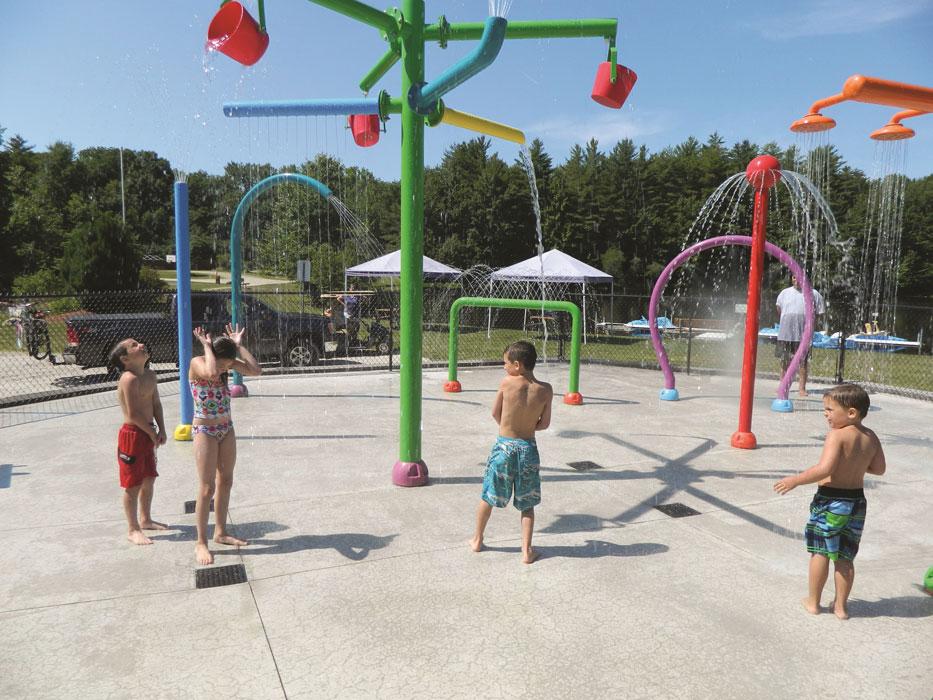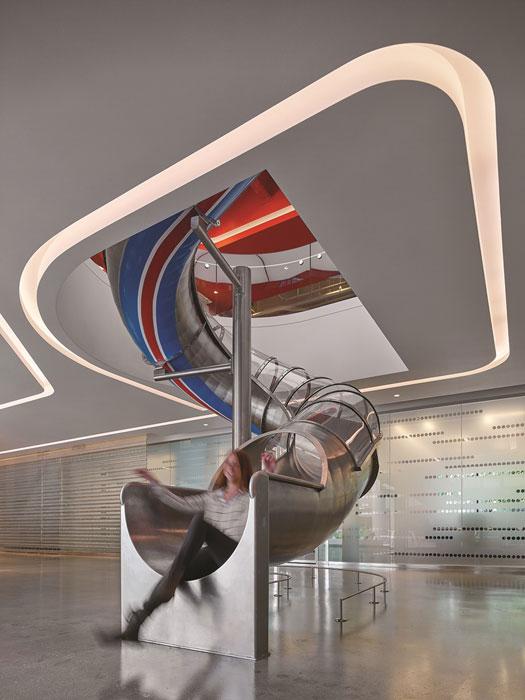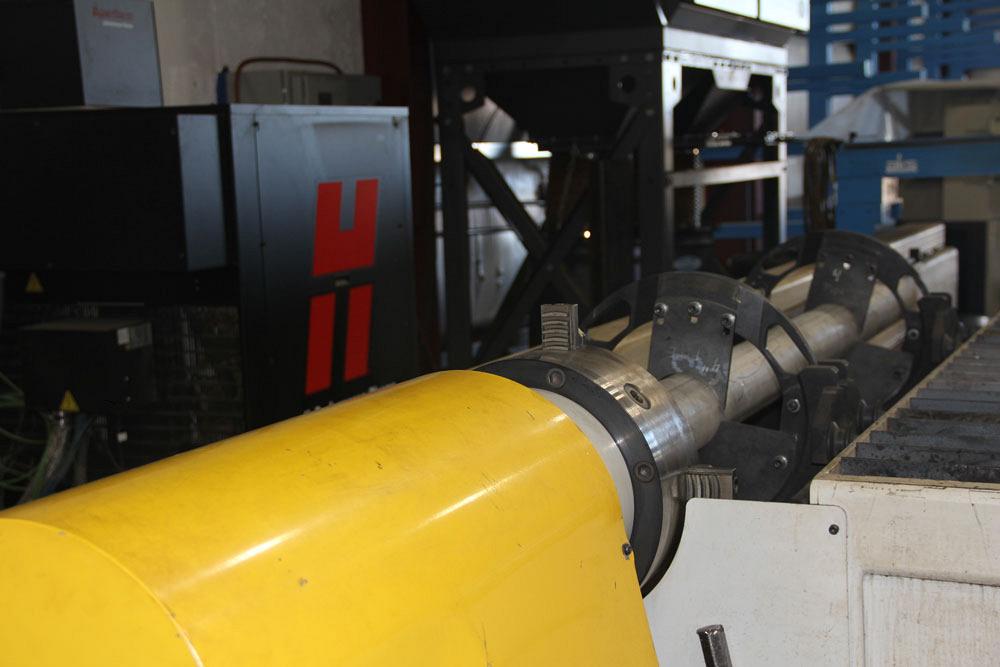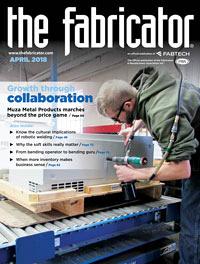Editor-in-Chief
- FMA
- The Fabricator
- FABTECH
- Canadian Metalworking
Categories
- Additive Manufacturing
- Aluminum Welding
- Arc Welding
- Assembly and Joining
- Automation and Robotics
- Bending and Forming
- Consumables
- Cutting and Weld Prep
- Electric Vehicles
- En Español
- Finishing
- Hydroforming
- Laser Cutting
- Laser Welding
- Machining
- Manufacturing Software
- Materials Handling
- Metals/Materials
- Oxyfuel Cutting
- Plasma Cutting
- Power Tools
- Punching and Other Holemaking
- Roll Forming
- Safety
- Sawing
- Shearing
- Shop Management
- Testing and Measuring
- Tube and Pipe Fabrication
- Tube and Pipe Production
- Waterjet Cutting
Industry Directory
Webcasts
Podcasts
FAB 40
Advertise
Subscribe
Account Login
Search
Switching to precision plasma cutting
Precision plasma, rotary cutting, and programming software makes manufacturing more efficient for Natural Structures
- By Dan Davis
- April 9, 2018
- Article
- Plasma Cutting

Figure 1
In fabricating play structures for pools and waterparks, Natural Structures works with a lot of tube and pipe.
Photo courtesy of Natural Structures.
Who says that metal fabricating isn’t fun? Natural Structures, Baker City, Ore., has built a business around that concept.
The business specializes in the design, engineering, and fabrication of pavilions and shelters found in parks and campgrounds; water slides and water play structures found in pools and splash pads (see Figure 1); and amenities such as tables, benches, and bike racks that might be found at those facilities. It also has gotten into the business of fabricating stainless steel slides (see Figure 2) that are finding homes in the headquarters of major financial institutions and Silicon Valley companies.
“What’s happening at these businesses is that they are hiring a lot of these millennials, and they want to retain these employees,” said Jodie Hausotter, one of the company owners. “To do that, they are installing slides and other items to create an atmosphere of fun and games.”
Who can say “no” to a slide? Apparently not a lot of people.
Natural Structures got into the business of manufacturing slides for pools because, honestly, these water recreational areas were kind of boring without them. Well, the same can be said for office environments. People can’t really resist sliding down from the second floor to the first floor, unless they happen to have a full coffee cup in their hands.
But don’t think that these slides are the same plastic models you see at the water park. These are high-end stainless steel slides that reflect a refined work environment with a wink to the whimsical side of office life. It’s serious business developing these fun work accessories.
These stainless steel fabrications became a growing part of the company’s business over the past five years. It also added an element of complexity, with its need for higher tolerances, especially when compared to some of the other metal fabricated items where a tolerance within 1/16 in. was OK.
As fabricator Steve Willits described, “Imagine putting 10 holes in a ¼-in.-thick stainless steel plate, laying them out, drilling by hand, and then tapping them. That’s a pain.”
Company owner Ted Hausotter was even more direct: “Literally, it would just stop the shop.”
This high-end metal fabricating work, along with a general project building hydraulic boxes for a Portland-based customer, forced Natural Structures to take a look at precision plasma cutting technology. It had a plasma table it purchased in 2008, but it just wasn’t able to keep up with the manufacturing realities of a decade later.

Figure 2
Stainless steel slides are a significant growth area for Natural Structures. As a result, the company needed higher-precision cutting capability. It’s one of the reasons it invested in a high-definition plasma cutting system in 2017. Photo courtesy of Natural Structures.
“We knew better technology was there. It was just a matter of how much capability do you want to buy,” Ted said. “But what we found was that we were spending the money already without having high-definition plasma. We were fixing holes after they were cut with the plasma and repunching them. Basically, our old plasma table was being used as a marking table.”
New Plasma Cutting Performance
After more than six months of searching, the Hausotters purchased and installed an AKS Cutting Systems dura-kut CNC plasma cutting table with a 6- by 12-ft. table for 2-D cutting and rotary axis tube cutting capability. The new table incorporates Hypertherm’s EDGE® Connect CNC and HyPerformance® HPR400XD® plasma system and is programmed with Hypertherm CAM software using ProNest® for plate nesting.
The HPR400XD uses Hypertherm’s HyDefinition® technology that aligns and focuses the plasma arc for a more precise cut on plate. Company officials report that a fabricator can get a dross-free cut in most instances when cutting mild steel in thicknesses up to 1.5 in. It has a maximum cutting capacity of 3.2 in. In stainless steel, the technology is designed to deliver consistent and high-tolerance cutting in material from 12 gauge to 0.25 in.
The cutting table also has AKS Cutting Systems’ tube-kut option, which is powered by Hypertherm’s Rotary Tube Pro™ software (see Figure 3). A headstock, four-jaw chuck rotates as the plasma torch cuts the tube wall. Ted said that Natural Structures is cutting up to 14-in.-diameter tube on the new equipment.
He also noted that the new equipment delivered in terms of meeting the high tolerances required of its jobs.
“It’s saved us hours in our stainless steel slide line,” Ted said. “It took a bit for us to learn how to cut accurately on 12-gauge stainless. There is a lot of heat movement with the material during cutting.
“Once we solved the heat issues and got an understanding of how to cut, we are now able get down to three-thousandths of an inch in terms of tolerance,” he added. “When we were off a little more than sixteenth of an inch with the old plasma system, that would cause problems. When you would put 10 pieces together that are off by a sixteenth of an inch to make an entry elbow, that would add up quickly and become a major problem.”
Also with the precision cutting, fabricators don’t have to worry about cleaning up holes and excessive dross. The speed and accuracy of the new plasma cutting system are keeping fabricators focused on finalizing orders, not rework.
Additionally, fabricators don’t have to worry about weld prepping plate coming off the table either. The new plasma torch is capable of cutting A, V, K, X, top Y, and bottom Y bevel cuts; countersinks, and chamfers.
Efficiency is not only being found on the cutting table, but also in programming the unit (see Figure 4). Willits said that the perfect example to illustrate the time savings is in holemaking. With the older software, he said he had to painstakingly focus on lead-ins and lead-outs of holes to ensure that they might be usable. The latest version of the ProNest software makes all of those calculations automatically. Using Hypertherm’s True Hole® technology adjusts gas flow, amperage, piercing methodology, lead-in/lead-out technique, and cutting speed in accordance with the material and size of the hole being cut.

Figure 3
The tube and pipe cutting capability of the new plasma cutting system enables fitters and welders to focus on final assembly, not hand-cutting holes and finishing them. Photo courtesy of Hypertherm.
“Something that might have taken me more than three or four hours on the old version of the software, now takes me about 10 minutes,” Willits said.
There’s also no time spent trying to take 3-D models and recreate them into flat drawings that can be processed, as would happen with the older software.
“This is really helpful when working with something like SolidWorks,” Willits said. “They just give me a STEP file now, and I have no programming to do. I just import the file, and the software creates the NC code for them to start burning parts.”
Better Designs for Tomorrow
The rotary cutting capability is helpful for today, as about a third of Natural Structures’ fabrication work involves pipe, but Ted said the focus is really on tomorrow.
“To be able to process it at strange angles or developing holes so that tubes can go right through another tube is going to allow our designs not to look so engineered,” Ted said. “Once we get to that point, it will allow us to stop our competitors from trying to erode our market share.”
While outside observers may believe this play structure business to be insulated from global competitors, they would be wrong. Natural Structures has competitors in Canada and Mexico, and products from places like Germany and Turkey are increasingly more visible in the market place.
“With rotary tube cutting, we have the capability to go in a new direction,” Ted said.
Again, the plasma cutting system’s precision cutting and accuracy have delivered a whole new level of productivity when it comes to tube and pipe fabrication. Willits said fitters used to need hours to cut all of the holes and bevels into the tubes and pipes, but now all of those cuts can be done in minutes on the plasma table.
The fit-up is so good that as pipes destined to be part of water parks are tested for leaks Natural Structures is finding few leaks.
“Who would have thought that people would be concerned about leaks at a water park? But they are,” Ted noted.
Where’s the fun in that?
Natural Structures, www.naturalstructures.com
Hypertherm, www.hypertherm.com
AKS Cutting Systems, www.akscutting.com
What Modern Software Can Do For A Fabricator
Even though Natural Structures, Baker City, Ore., has a product line that is clearly defined in colorful brochures, it probably has more in common with a job shop. Everything it fabricates is custom, even if it may be based on a water play structure design that’s appeared somewhere else. It has to be fabricated from scratch, and the water play structure is likely to join other fabrications that will be unique to the park where the equipment is erected.
With that mix of fabricating work and an expanding business, the shop floor can feel the pressure to get fabrications out the door as quickly as possible to get on to the next job. But in the search for more productivity, a fabricator shouldn’t limit itself to the shop. Sometimes time can be saved by streamlining front-office activities such as nesting and machine programming.
The FABRICATOR spoke with Derek Weston, product marketing manager for Hypertherm’s ProNest and Rotary Tube Pro software, about what modern software can do for fab shops that might be working with software that hasn’t been updated over the years.
The FABRICATOR: What are fabricators missing out if they are relying on CAD/CAM nesting software that is more than a decade old?
Derek Weston: In general, I would say that it’s the ease of use and the built-in expertise relative to the specific cut process and the application that they’re using. So, for example, a fabricator cutting with plasma and using a bevel head will have all of those parameters preloaded via a software setup that goes along with that particular brand and model of cutting machine. From day one, that fabricator can output code that’s going to cut high-quality parts.
For a company that is challenged to find skilled workers, this is a huge benefit. Right from the beginning, they’re going to get consistent, high-quality results regardless of the operator and regardless of the operator’s skill level.
FAB: Based on feedback from fabricators, it doesn’t take a lot of manufacturing software experience to pick up on using modern CAD/CAM nesting software. Do you see that to be the case?
Weston: What Hypertherm has done is minimized the number of clicks and minimized the decisions a programmer and cutting machine operator might have to make. We have essentially automated all that stuff so it happens in the background. The programmer might typically indicate the material type and thickness being cut and then provide the software with an idea of what’s more important: speed or cut quality. From there, all of the cutting parameters line up in the background. Optimal feed rates and slow-downs are applied, and kerf is correct. Lead-in style, length, and location also are all automatically optimized. Obviously the nesting, in terms of optimization of the material and the tool cutting paths, is automated as well.
Most tasks that were previously manual are now taken care of automatically, behind the scenes. Depending on the level of integration with the company’s ERP or MRP software, work orders may be imported, combined based on various priorities, efficiently nested to include skeleton cuts and crop lines as part of the job; material inventory updated; and NC code output generated automatically—all via the nesting software. Your older, legacy software would not allow for that. Often, those older legacy systems were actually a bunch of executables stacked on top of each other, so you had to open multiple programs which would just share data back and forth. That’s not the situation with today’s modern software, which is fully seamless and integrated.
FAB: What type of learning curve is necessary to become comfortable with this type of software?
Weston: Initial training covers the basics of going from importing CAD files through outputting code. We get folks acquainted with it and let them explore from there.
Generally, the next questions we receive require an additional training session, which in our case is part of our annual software maintenance entitlement. We would then get into providing in-depth coverage of maybe bevel cutting and how to really get the most out of that module when your cutting and how to really get the most out of that module when your cutting flat parts.
FAB: Do you see this software as a tool the really opens up the design possibilities for a fabricator and energizes its business?
Weston: There are two aspects to this. Imagine that you were trying to take a 3-D SolidWorks design, but the programming software didn’t have the capability to just import it. You would have to try and recreate it manually, which takes a ton of time, and then you still wouldn’t necessarily be sure that the flat layout really represented what you hoped to achieve. With today’s software, you can import that 3-D file and completely eliminate the design guesswork that otherwise would’ve occurred in the past. So you can produce much more complex designs with a higher confidence level that you’re going to achieve an optimal outcome.
The second issue relates back to the operator because, again, the cutting process essentially is automated. There’s no operator guesswork involved in terms of selecting cutting parameters. So now the output from the machine is increased, freeing up machine time and presenting additional opportunities.
About the Author

Dan Davis
2135 Point Blvd.
Elgin, IL 60123
815-227-8281
Dan Davis is editor-in-chief of The Fabricator, the industry's most widely circulated metal fabricating magazine, and its sister publications, The Tube & Pipe Journal and The Welder. He has been with the publications since April 2002.
subscribe now

The Fabricator is North America's leading magazine for the metal forming and fabricating industry. The magazine delivers the news, technical articles, and case histories that enable fabricators to do their jobs more efficiently. The Fabricator has served the industry since 1970.
start your free subscription- Stay connected from anywhere

Easily access valuable industry resources now with full access to the digital edition of The Fabricator.

Easily access valuable industry resources now with full access to the digital edition of The Welder.

Easily access valuable industry resources now with full access to the digital edition of The Tube and Pipe Journal.
- Podcasting
- Podcast:
- The Fabricator Podcast
- Published:
- 04/16/2024
- Running Time:
- 63:29
In this episode of The Fabricator Podcast, Caleb Chamberlain, co-founder and CEO of OSH Cut, discusses his company’s...
- Trending Articles
AI, machine learning, and the future of metal fabrication

Employee ownership: The best way to ensure engagement

Steel industry reacts to Nucor’s new weekly published HRC price

Dynamic Metal blossoms with each passing year

Metal fabrication management: A guide for new supervisors

- Industry Events
16th Annual Safety Conference
- April 30 - May 1, 2024
- Elgin,
Pipe and Tube Conference
- May 21 - 22, 2024
- Omaha, NE
World-Class Roll Forming Workshop
- June 5 - 6, 2024
- Louisville, KY
Advanced Laser Application Workshop
- June 25 - 27, 2024
- Novi, MI


























